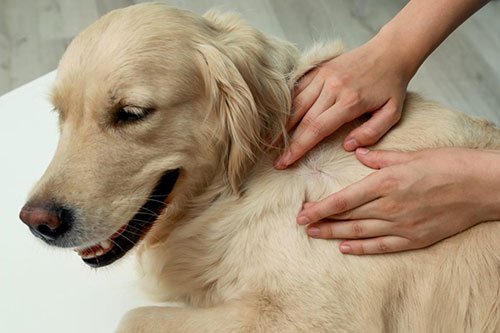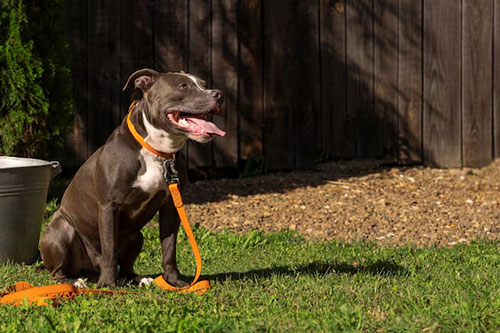Monoclonal Antibodies For Dogs: The Complete FAQ Guide In 2025
Is your dog suffering from pain, allergies, cancer or chronic conditions and traditional treatments just can’t seem to solve? Are you waiting for the safer solution and the way that treats your dog with the same precision medicines used in humans? Monoclonal antibodies is the revolutionized way of modern solution that can helps your dog live a longer and healthier life.
In 2025, this safer solution of monoclonal antibodies is the best option for curing the inflammation and diseases in your dog. In this guide, you will walk through everything related to monoclonal antibodies including how they work, their benefits, the possible side effects, manufacturing and the machines involved in making monoclonal antibodies for dogs. Are you ready for exploring the amazing world of monoclonal antibodies for dogs? Let’s start!
1.What are monoclonal antibodies for dogs?
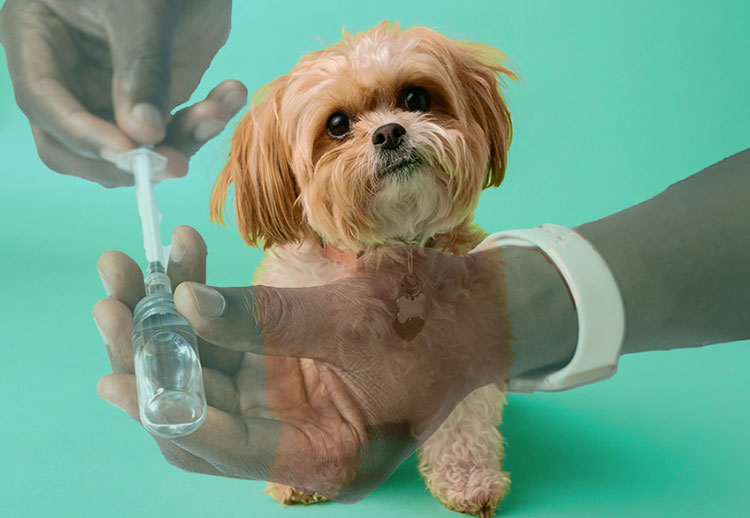
Monoclonal antibodies for dog-Picture courtesy: vetmed.illinois.edu
Monoclonal antibodies for dogs are pre-made antibodies that fight against the foreign agents. These monoclinic antibodies are synthesized in laboratory and when injected into the body of dog, it boost up the immune system. When the monoclonal antibody finds the target antigen, the immune cells rushed to the antigen site and kills the disease causing antigens. In this way, the dog body is protected from itching, inflammations and infections.
2.How the monoclonal antibodies work in the body of dogs?
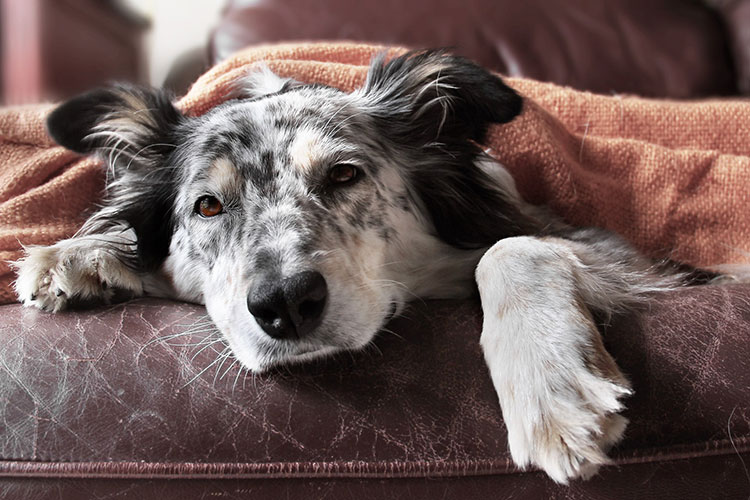
Monoclonal antibodies against diseases in dog- Picture courtesy: yourpetandyou.elanco.com
Have you injected the monoclonal antibodies in your dog body and the dog recovered from the disease immediately? But what’s going on in the body of dog or how the monoclonal antibodies worked in the body of dog. The step by step working of these antibodies in the body of dog are as follows:
| Steps | Description |
| Recognize a specific target | The body has an immune system that form antibodies against the foreign agents. When the virus or bacteria enter the body that cause disease in the body, the immune system immediately start forming against the foreign agents. The antibodies react with the antigens (foreign agents) and try to destroy it. These pre-made monoclonal antibodies recognize the antigens that involve in the disease causing. |
| Bind to the target | The injected monoclonal antibodies circulate in the bloodstream of the dog. These antibodies are very sharp and immediately find the antigens or disease causing proteins. The antibodies attaches tightly to these antigens and target has been started. |
| Block the disease process | When these antibodies bind to the antigens, it stops the antigens from sending harmful signals to the body. Do you know what the harmful signals are? The antigens has a normal function to send a harmful signals to the body that creates itching and inflammation etc. but when the active monoclonal antibodies blocks the process, then body cells becomes safe. |
| Help the immune system | The monoclonal antibodies also mimic the immune system to destroy the harmful cells. The inflammatory signals is being stopped by the immune system. If the antigens normal function is to transmit pain, then the immune system prevents them from reaching the brain. |
| Stay active for weeks | The laboratory made or pre-made monoclonal antibodies that are synthesized for the purpose of preventing the body from infections and inflammation may last for 4 to 8 weeks. So, with a single injection, the dog body may safe from attacking of any foreign agents. |
3.Enlist the diseases and conditions that can monoclonal antibodies for dogs treat?
Your dogs may get itching, inflammation or infections, have you ever thought if your dogs can get precise treatment like the human do? Ever thought of the solution that can just block the disease causing protein without harming the rest of the body of the dog? Yes it is possible only by using monoclonal antibodies. But what disease they actually treat? Let’s find out!
Atopic dermatitis ( canine allergic skin disease)
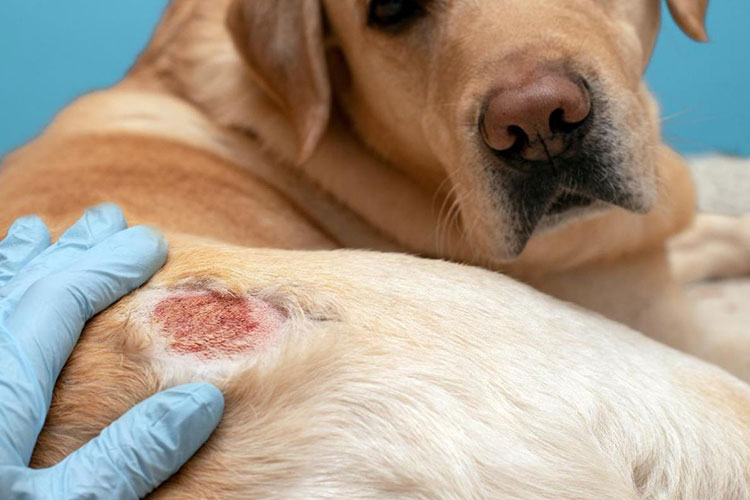
Atopic dermatitis in dog-Picture courtesy: dhah.org
If you noticed your dog itching, scratching itself and got inflammation then the dog body may exposed to the antigens that overactive the immune system to allergens. By this, the body can feel itching and skin inflammation. But when you inject the monoclonal antibodies into the body of the dog, then it binds and blocks the specific molecule that caused itching.
Itching creating antigen in dog:
In dog body, the molecule that increase the sensation of itching is interleukin-31. This is the molecule where monoclonal antibodies attached and block its function.
Functional in the body:
After the injection of monoclonal antibodies in the body of dog, the dog may not experience itching again for 4-8 weeks.
Chronic pain from osteoarthritis:
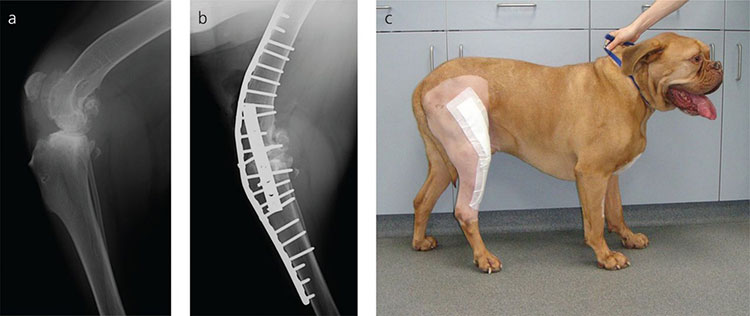
Osteoarthritis in dog-Picture courtesy: bvajournals.onlinelibrary.wiley.com
Have you noticed your cute dog is uncomfortable and unhappy with the joint pain? For the comfort of dog, you should inject the monoclonal antibodies in its body. You know the nerve growth factor (NGF) is the molecule that increase the sensitivity to pain in damaged joints in dog body. When the monoclonal antibodies injected into the dog body, it finds and binds to NGF and stops the normal function of it. The pain sensation can stops to reaching the brain of the dog and hence, your dog can live quality life with it.
Cancer:

Cancer in dog
The monoclonal antibodies are also used for the treatment of various cancers in the dog body. The tumor associated monoclonal antibodies are injected into the dog body, where they find the proteins that found in cancerous cells. They find to those harmful protein and signal the immune system to destroy them. They can also block the cancer cells that hide from the immune system.
Autoimmune and inflammatory disease:
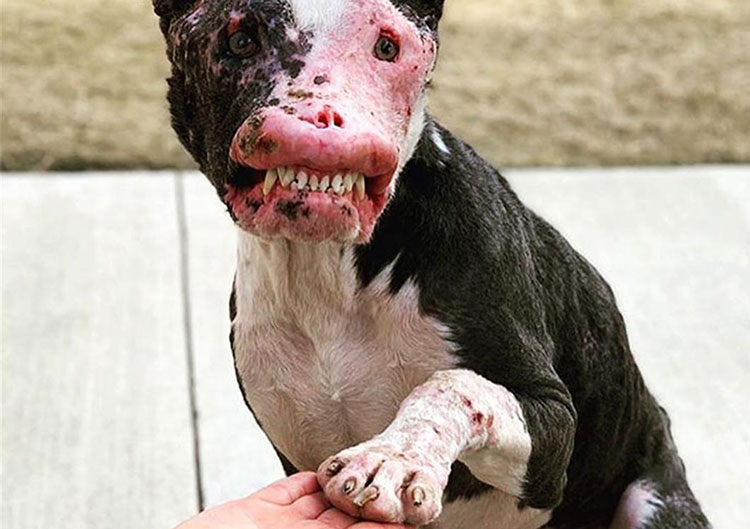
Autoimmune disease in dog-Picture courtesy: wellnessvet.com
Sometimes, the body immune system attacks on their own tissues. The example of such diseases are autoimmune arthritis, and immune mediated hemolytic anemia. When specific monoclonal antibodies injected into the dog body, they find the inflammatory cytokines. They binds to them and stops the signal of immune system to attack on the dog own tissues.
Infectious diseases:
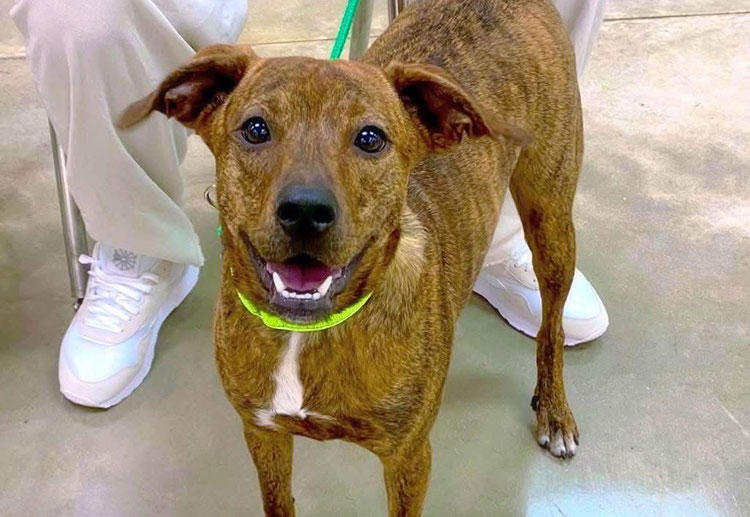
Infectious disease in dog-Picture courtesy: concordanimalhospital.com
Do you know the viruses and bacteria’s are diseases causing? When they enter the dog body, infections occur. But for avoiding the infections, you should inject the monoclonal antibodies into the body of dog where they find the viruses and bacteria’s and tightly binds to them. In this way, the monoclonal antibodies helps the dog immune system to fight against the infections.
Neurological pain syndrome:

Neurological pain in dog-Picture courtesy: wagwalking.com
If your dog is suffered from chronic nerve pain or post injury pains then the monoclonal antibodies help the dog body to reduce the chronic pain without the using of steroids. The monoclonal antibodies act upon the nerve signaling molecule and binds to them. The nerves may not transmit the signals to the brain and reduce the pain intensity.
4.Are there different types of monoclonal antibodies for dogs available?
Do you wants a monoclonal antibodies for your dog for a specific target? Well, there are various types of monoclonal antibodies for dogs are available depending upon the target molecule and therapeutic purpose. The types of monoclonal antibodies for dogs are available or under development are as follows:
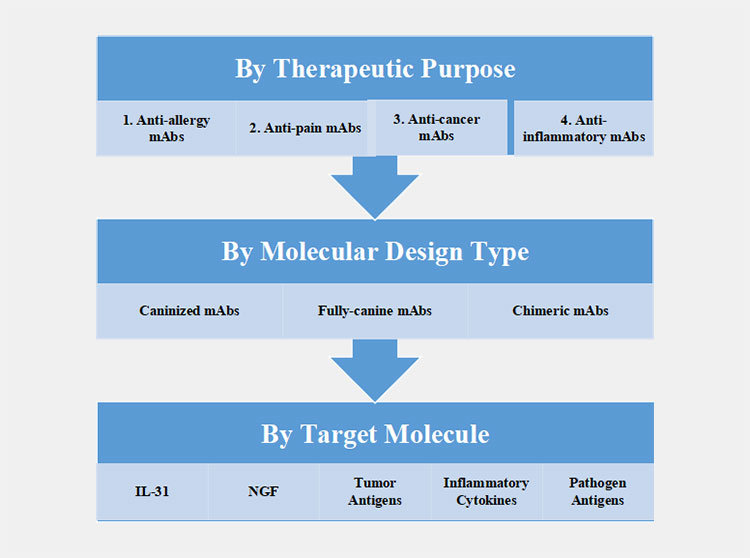
By Therapeutic Purpose
Anti-allergy monoclonal antibodies (mAbs):
The monoclonal antibodies are designed to treats the atopic dermatitis. Do you know what the atopic dermatitis is? When your dog is itching itself or allergic skin inflammation occur. The caninized monoclonal antibodies injected into the dog body where these antibodies circulate and find the interleukin-31. Here they binds and reduce the itching sensation in dog body.
Anti-pain monoclonal antibodies:
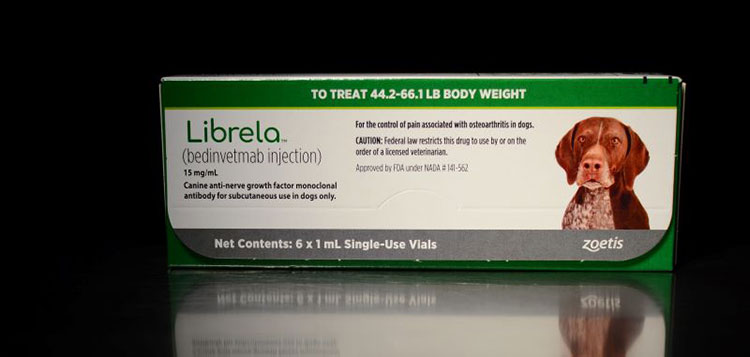
Anti-pain monoclonal antibodies for dogs-Picture courtesy: eveshamvet.com
These antibodies are testing in clinical trials. The anti-nerve growth factor is used to manage the chronic osteoarthritis pain and other chronic pain syndrome. These monoclonal antibodies act upon and binds to nerve growth factor and stops the signaling reach to the brain.
Anti-cancer monoclonal antibodies:
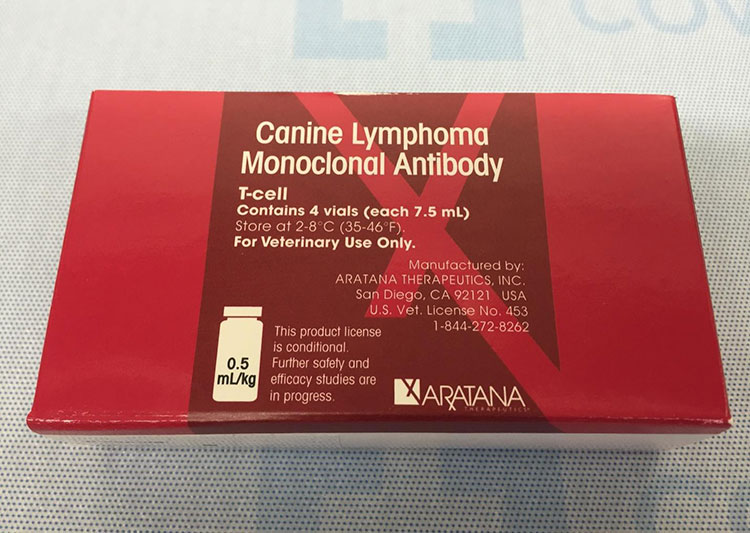
Anti-cancer monoclonal antibodies for dog-Picture courtesy: petmd.com
These monoclonal antibodies are in research stage but they are developing to target the specific proteins present in tumor or cancerous cells. These antibodies find the antigens and binds to tumor specific antigens. The immune system of the dog responded and kills the cancerous or tumor cells.
Anti-inflammatory monoclonal antibodies:
Sometimes dog own immune system respond against its own body tissues and create a diseases like immune mediated arthritis and lupus. But these monoclonal antibodies work against it and targets the cytokines.
By Molecular Design Type
Caninized monoclonal antibodies:
The caninized monoclonal antibodies are made in laboratory but these are similar to dog natural antibodies. Lokivetmab, anti-nerve growth factors are the examples of such monoclonal antibodies.
Fully caninized monoclonal antibodies:
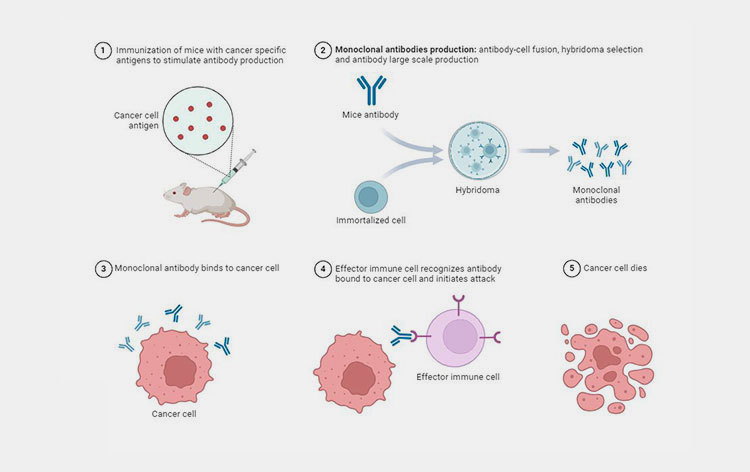
Monoclonal antibodies against cancerous cells-Picture courtesy: biotechreality.com
The fully caninized monoclonal antibodies are derived from canine genes. When injected into the body of dogs, the dog immune system recognized them as they are their own made antibodies. These antibodies are under experiments and work against the cancers in dogs.
Chimeric monoclonal antibodies:
The monoclonal antibodies are synthesized when gene cloning occur. The genes that encode the antibody sequence is extracted from the dog. The other genes or antibody sequence is eliminated from other species like mice. These antibodies sequence are combine and form recombinant genes. These monoclonal antibodies are used against cancer and helpful in cancer treatment.
By Target Molecule
The target of monoclonal antibodies are as follows:
IL-31:
The allergic skin disease is caused by IL-31. The monoclonal antibodies specifically act upon the target IL-31. Examples of such monoclonal antibodies are Lokivetmab (cytopoint ®).
NGF:
Is your dog suffering from arthritis pain or osteoarthritis pain? The monoclonal antibodies act upon nerve growth factor and reduce the sensation of pain. The example of such monoclonal antibodies are anti-NGF.
Tumor antigens:
The target of such monoclonal antibodies are tumor antigens. These monoclonal antibodies are used to treat the melanoma and lymphoma in dog body.
Inflammatory cytokines:
The autoimmune diseases are due to the inflammatory cytokines especially TNF-alpha, IL-6. The monoclonal antibodies act upon cytokines and prevent the autoimmune diseases.
Pathogen antigens:
The monoclonal antibodies target is to bind to pathogen antigens and reduce the infectious diseases in the body of dogs.
5.What are the possible side effects of monoclonal antibodies for dogs?
Although the monoclonal antibodies is very effective medications against various diseases. But have you ever wondered, almost all the medications have risks or side effects, is there any side effects of using monoclonal antibodies? Yes, there is a minor to mild risks of monoclonal antibodies in dog’s body. Let’s explore them.
| Side effects | Description |
| Injection site reaction
Injection site reaction |
When you inject the monoclonal antibodies into the body of dog, sometimes you experience that the injection site became red or swelled. But this can be temporary and recovered in 1 to 3 days. Don’t you worry about this, because it often don’t require treatment. |
| Hypersensitivity
Swelling of face of dog |
As you know the monoclonal antibodies are proteins and sometimes, the dog immune system recognize them as foreign agents and react against them. This may cause swelling of the face of dog, difficulty in breathing and vomiting. But the reaction case in very rare but if occurred, the dog needs emergency care. |
| Development of anti-drug antibodies | Sometimes the body immune system of the dog produce antibodies against the monoclonal antibodies resulting in less effectiveness of the treatment. This can be occurred with a fully caninized products. |
| Gastrointestinal upset
Diarrhea in dog- Picture courtesy getodie.com |
In some dogs, the immune system is not that so strong. So, when monoclonal antibodies injected into the dog body, the stomach upset results. Due to this, loss of appetite, mild diarrhea and vomiting occur. But this is for the short term and resolve in its own. |
| Lethargy or fatigue
Lethargy in dog-Picture courtesy: Vets now |
After the injection of monoclonal antibodies, some dogs may feel tired or little quieter. But this can go after sometimes. |
6.How are monoclonal antibodies for dogs administered to pets?
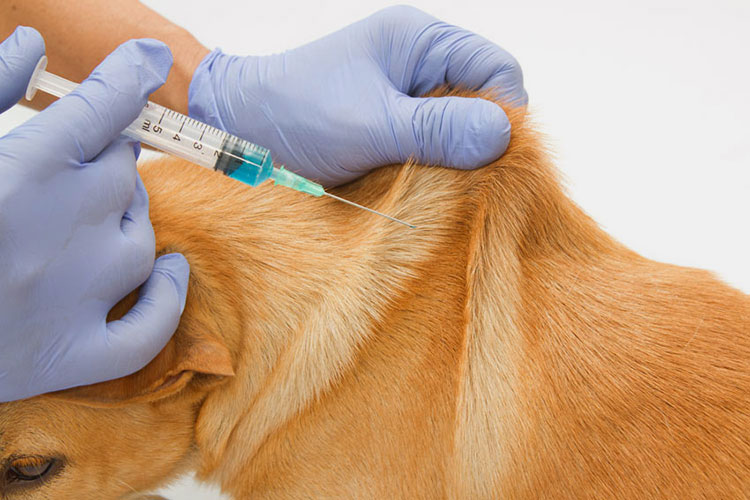
Monoclonal antibodies administration to dog-Picture courtesy: omlet.co.uk
When you wants to inject the monoclonal antibodies into the dog body and you wondered, should you give it orally, mixed with food or inject it into the dog body. You should not apply the monoclonal antibodies into the dog body orally, instead you should inject them.
You should inject them directly under the skin subcutaneously or through intravenously. Monoclonal antibodies should never be given orally because monoclonal antibodies are protein and would be broken down.
For injecting the monoclonal antibodies into the dog skin, you should disinfect and clean the area.
After that, inject the monoclonal antibodies under the skin or into the veins. The antibodies will circulate in the dog body and will reach the antigens. The immune system will boost and other cells will rush to kill the antigens.
7.What steps to be followed to manufactures the monoclonal antibodies for dogs?
Antibodies are special proteins that are released by the body immune system in response to the foreign agents or antigens. Monoclonal, mono means one and clonal means copy, these monoclonal antibodies are made or the copy of one a single antibody. They are synthesized to target one specific proteins in the body called antigens. This means that the specified monoclonal antibody is synthesized to attack one type of antigen. So the manufacturing steps of monoclonal antibodies for dogs are as follows:
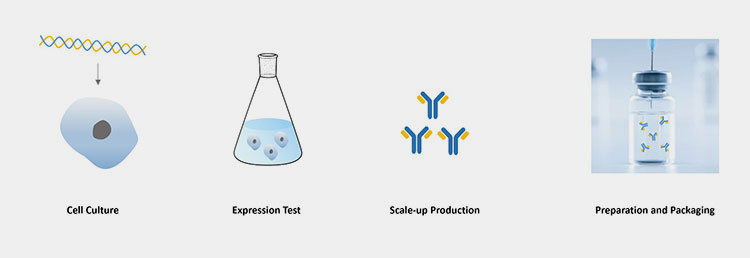
Manufacturing of monoclonal antibodies- Picture courtesy formulationbio.com
Target identification:
If you are a researcher or a scientist, then first of all, you have to identify the target proteins. You must know the proteins or antigens that cause the disease. This protein is your target antigen. For example, for dogs itching, IL-31 is the protein or antigen that cause itching and irritation in the dog body. And this IL-31 is your target antigen.
Designing the antibody:
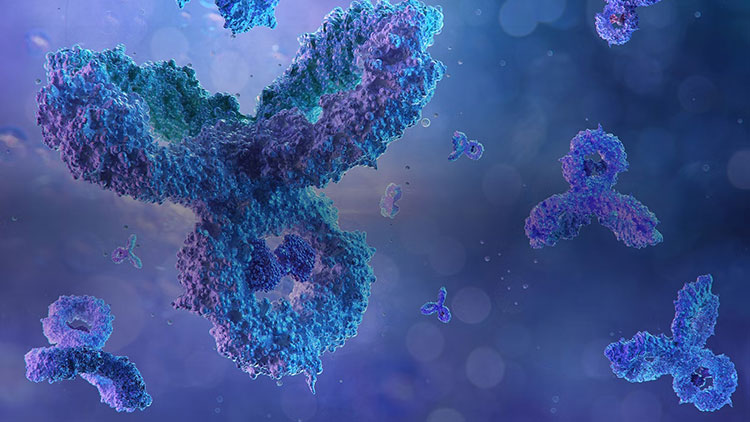
Designing of antibody
Next, you have to create a gene for the antibody that binds to the antigens tightly. You can extract the sequence of genes from other species like mice and then change the structure to make it safe for dogs. This process is known caninization.
Gene insertion:
The selected gene or the blueprint should then be inserted into the living cell that have capacity to reproduce itself. The living cell that is mostly used in laboratory for antibodies production is Chinese hamster ovary cell (CHO cells).
Cell culture ( growing the cells):
The cells produced are then shifted into the large tank called bioreactor. The bioreactor is fed with a nutrients like amino acid and sugar, maintain the PH and temperature. The nutrients helps in the growth of cells. Due to reproduction of these cells, the monoclonal antibodies are also produced. These monoclonal antibodies are released into the surrounding liquids.
Harvesting the antibodies:
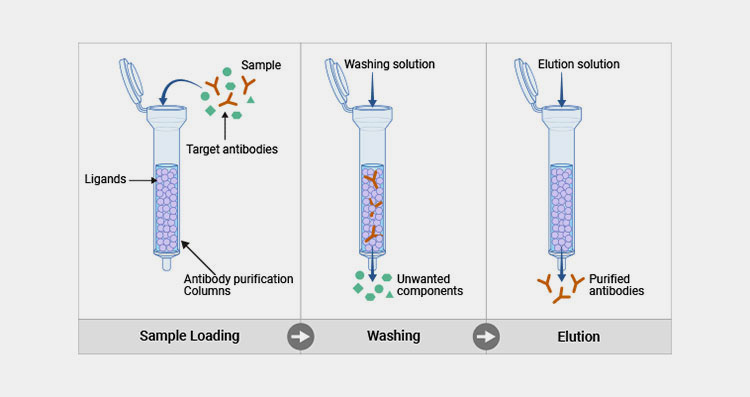
Harvesting the antibodies- Picture courtesy cusabio.com
The liquid rich in monoclonal antibodies is then passed through the centrifuge and filters. The centrifuge separate the heavier cells from the liquids. The filter is used to separate the debris in the liquid products. You will left with monoclonal antibody rich product but still have other proteins.
Purifying the antibody:
In the next step, you just need a pure monoclonal antibodies. For this purpose, chromatography column is used. One of the most commonly chromatography used is protein A chromatography. In this chromatography, the monoclonal antibodies is attached to the column while the rest proteins are then washed out. You will be leftover with a pure monoclonal antibodies after the purification procedure.
Viral safety and sterile filtration:
The monoclonal antibodies may contain virus and bacteria. For the sterile monoclonal antibodies production, you should passed the monoclonal antibodies through ultra-fine filters that removes the viruses. You will get safe and free of contaminant monoclonal antibodies.
Formulating the antibody:
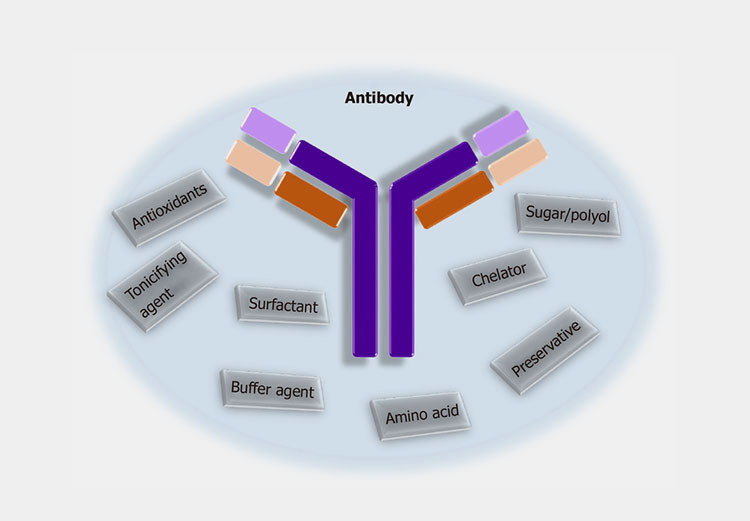
Formulating the monoclonal antibody- Picture courtesy: biointron.com
Now, the purified and sterile monoclonal antibodies is mixed with a stabilizers and buffers. For example, you should mix sugars for increasing the shelf life, salts to match the dog’s body fluid, and buffers to keep the pH balanced during usage and storage. This step is formulating and prepared the final injectable product.
Filling into vials :
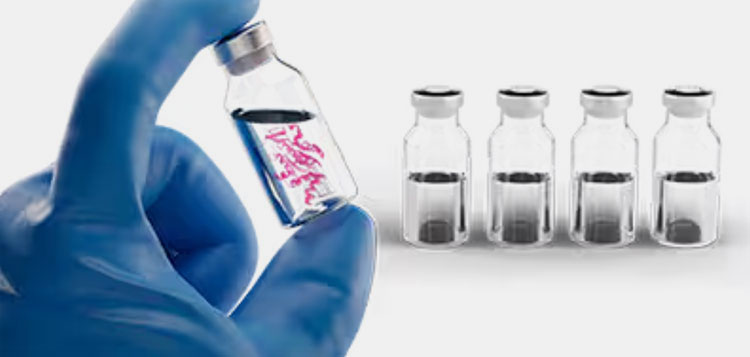
Filling the vials
The sterilized vials are filled with aseptic monoclonal antibodies which is then used to inject in the dog body. The vials are then sealed to preserve the product.
Quality control testing:
The monoclonal antibodies batch are then tested to check the safety, sterility, purity, potency and stability. If the product is clean, free from contaminants, free from bacteria and viruses then, you should proceed for the packaging.
Packaging and storage:
The vials are then packed into the cartons or boxes. The cartons are labeled with drug name, dosage, ingredients and way of injecting etc. the packed vials and syringes are then stored in refrigerator and temperature should be 2°C to 8°C.
8.Enlist the main machines involved in the manufacturing of monoclonal antibodies for dogs?
Are you researcher or scientist? Do you want to manufacture the monoclonal antibodies but wondering about the main machines involved in the production? So, for your convenience, the main machines that are used in the synthesis of monoclonal antibodies for dogs are as follows:
Electroporator ( cell line):
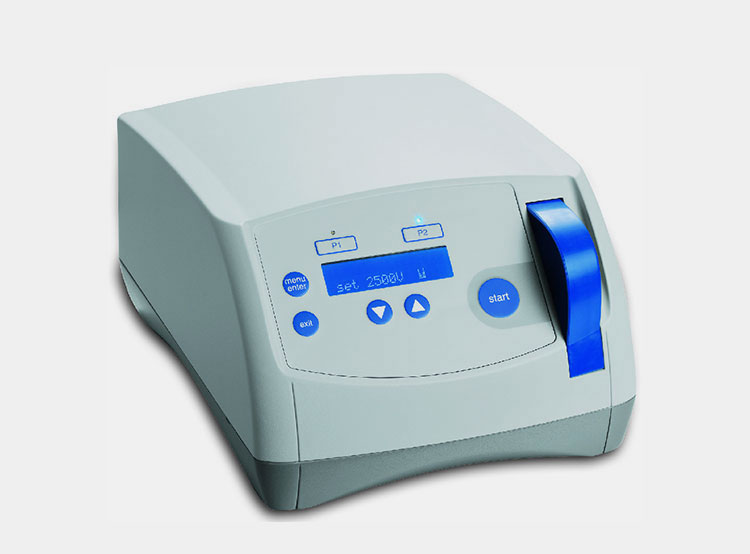
Electroporator-Picture courtesy: avantorsciences.com
The electroporator is a device which is used to insert the DNA that carries the gene that encodes the monoclonal antibody into the host cell or plasmid. This machine helps in the production of cell line that will continuously produce your desired monoclonal antibodies. In this machine, just a cell line is produced and the monoclonal antibodies will be produced in the next step i.e. bioreactor.
Upstream production:
The phase upstream production is the initial steps in the monoclonal antibodies for dog which involves the production of monoclonal antibodies from the living cell. It involves bioreactor where monoclonal antibodies are produced.
Bioreactor:
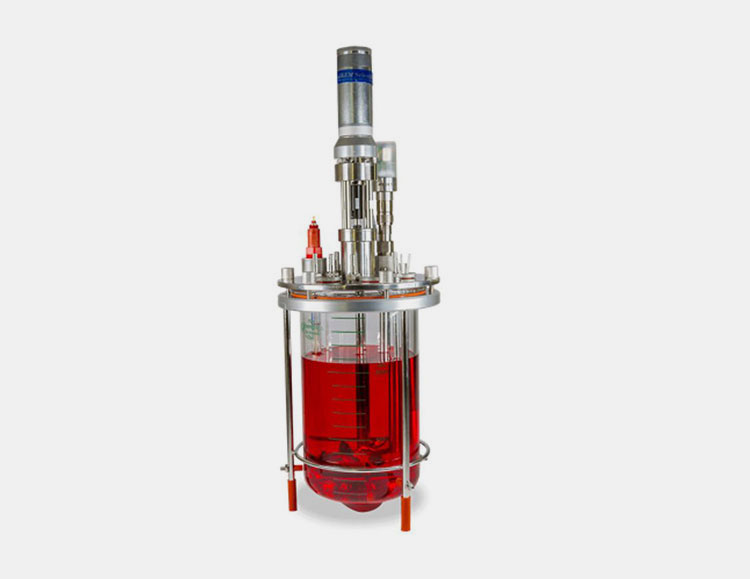
Bioreactor-Picture courtesy: maxongroup.com
Bioreactor is the heart of the production process. In bioreactor, the monoclonal antibodies containing cells are grows in thousands of liters of nutrient rich fluid. The fluid contain nutrients, incorporate with oxygen and carbon dioxide level, balanced PH and temperature.
Harvest:
In harvesting step, it is the process in which cell fluid culture that is rich in monoclonal antibodies is collected from the bioreactor. Centrifuge is used in the harvesting step.
Centrifuge:
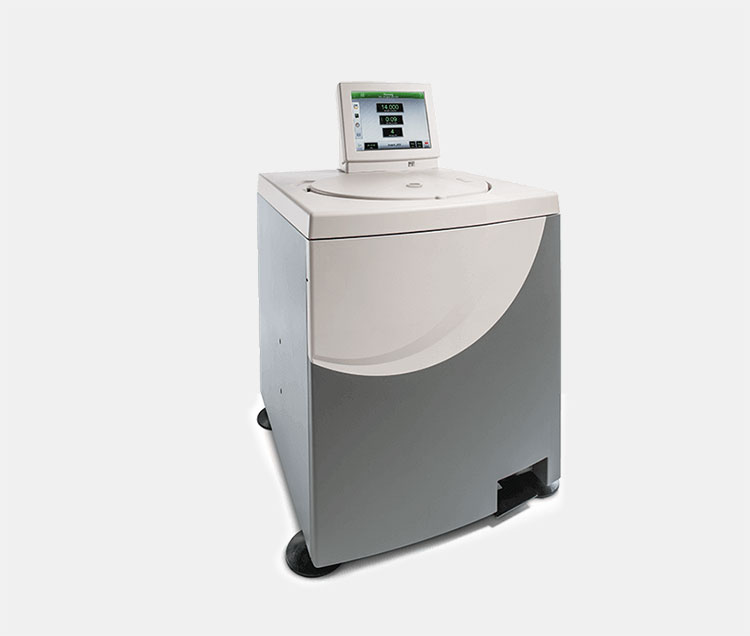
Centrifuge-Picture courtesy: analis.com
The fluids containing antibodies and other heavier cells are then spin in a centrifuge machine. Centrifuge spins the cell culture at a very high speed. The cells, larger particles and liquid contain monoclonal antibodies get separated in this machine. The liquid containing monoclonal antibodies are then proceed for further purification.
Purification system:
After the collection of monoclonal antibodies fluid, the fluid is further processed to the purification system. The system involves TFF system and chromatography system.
Tangential flow filtration system:
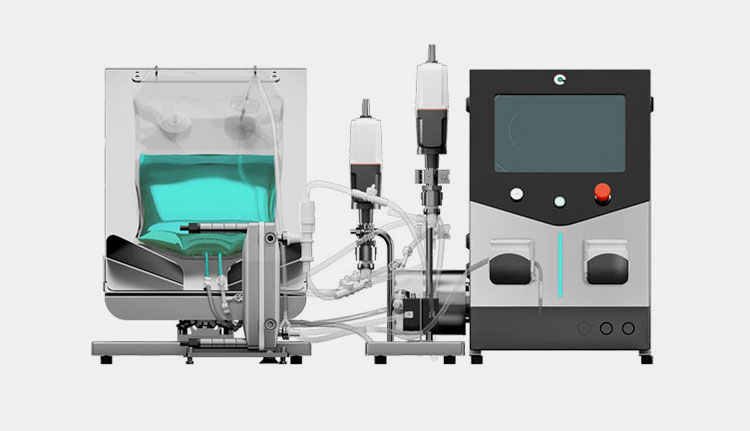
Tangential Flow Filtration System-Picture courtesy: pro-analytics
The liquid obtained from centrifuge machine contain monoclonal antibodies, salts, other proteins and various other materials. This product is then passed through tangential flow filtration system where it concentrate the monoclonal antibodies and filtered and washed away other materials present in the liquid. The liquid is filtered out sideways through the membranes. In this way, the volume of liquid reduced and solution is prepared for further purification.
Chromatography system:
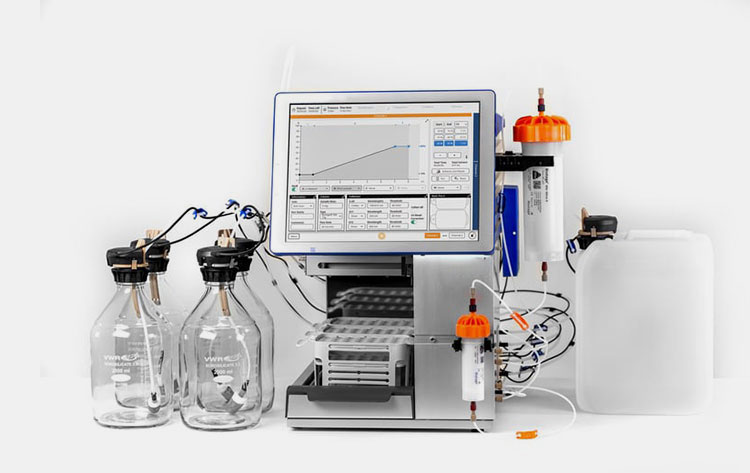
Chromatography system-Picture courtesy: biotage.com
The chromatography system ensures you to get the pure monoclonal antibodies. Special material in the column is designed that binds the specific protein. Usually protein A chromatography is used to binds the monoclonal antibodies and washed away other products. This machine ensures you to produce a high-purity monoclonal antibodies.
Viral safety
To get the high purity monoclonal antibodies, the virus or bacteria present in it must be removed to inactivate. So, for this purpose, you can use virus filters or viral inactivation equipment which is low pH tank and having filters.
Viral inactivation equipment:
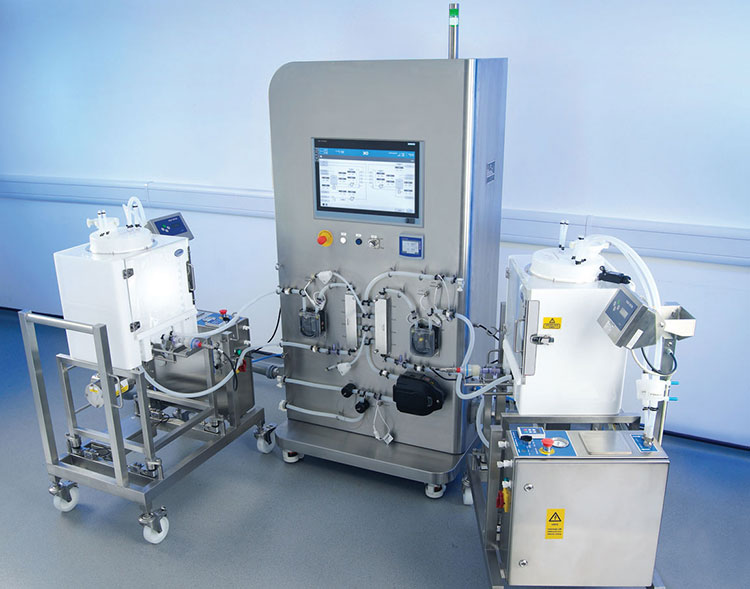
Viral inactivation equipment
The solution containing monoclonal antibodies may contain bacteria and viruses so, for obtaining the sterile product, you should use viral inactivation equipment. This equipment use high heat and chemicals usually having low pH that kills the viruses if present in the solution. The filters are present in it which filters out the viruses. This equipment ensures the biological safety of the final product.
Formulation:
For the formulation of monoclonal antibodies for dog, the tanks must be sterile and having mixers.
Formulation tank:
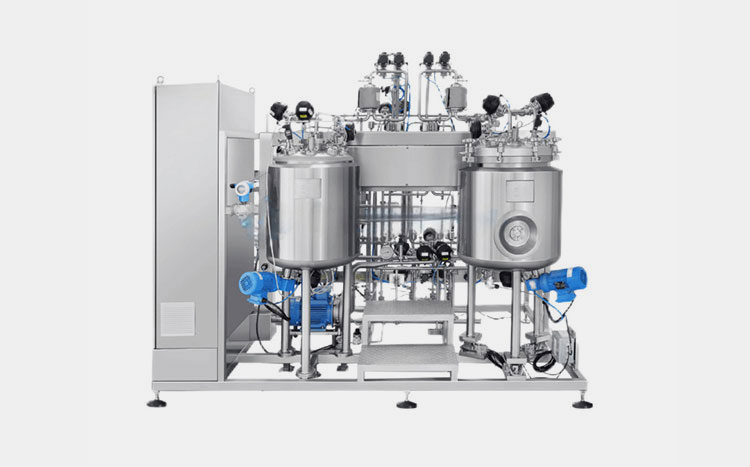
Formulation tank
Now, you have to prepare the final formulation. For this purpose, you can use formulation tank. In this tank, the nutrients like sugar, salts, and buffers are fed and adjust the temperature, speed of the impeller and pH of the solution. By the combined effort of temperature and stirring process, all the ingredients, excipients are mixed well with the monoclonal antibodies. In this way, you will get a perfect monoclonal antibodies formulation that could be safe during storage and use.
Filling machine:
The dogs’ monoclonal antibodies are filled into the vials. So, for filling purpose, vial liquid filling production line is used.
Vial liquid filling production line:
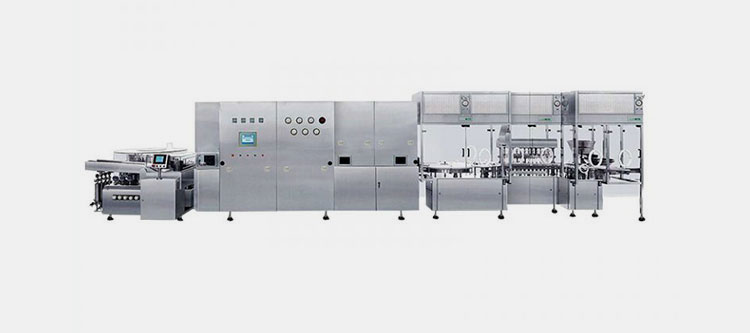
AIPAK engineering vial liquid filling machine
The vial production line is the complete set of machines having vials washing machine, drying machine, vial filling machine, stoppering machine and sealing machine is present. The vials are washed and sterilized in the machine, these vials are then processed to the drying. When the vials get dry, they are filled with a precise amount of monoclonal antibodies. The monoclonal antibodies in the vials are then protect by using stoppering. After the insertion of stoppers, the vials are sealed. All the machines involved in the above production line is GMP certified which means it ensures the sterility of the product.
Quality control analytical instruments:
The batch of monoclonal antibodies should be tested for the purity and effectiveness of the product before injecting into the dogs’ body. These equipment’s are laboratory based and are as follows:
ELISA reader:
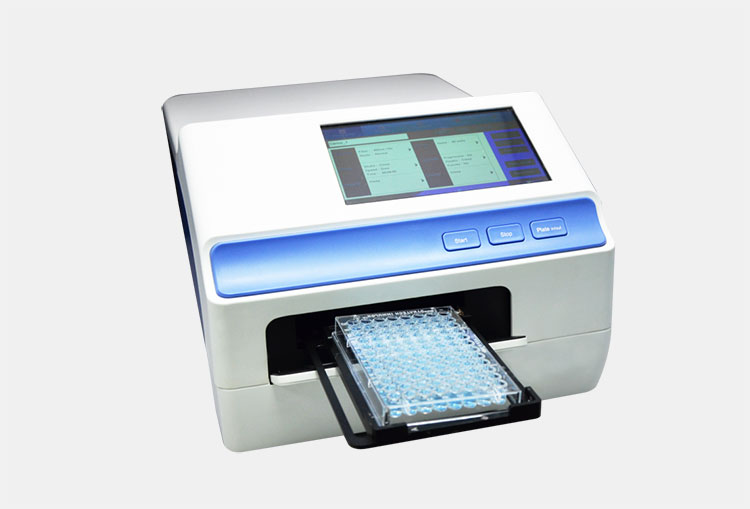
ELISA reader-Picture courtesy: hercuvan.com
The ELISA reader is laboratory machine which is used to detect the activity of the monoclonal antibody. This machine detect how well and actively the monoclonal antibody attaches and binds to the specific antigens. For example, if the monoclonal antibody has been designed that detect the IL-31 antigen in the dog body. So, in this machine, the plate is coated with such antigens. The monoclonal antibody is then add to such plate and then the scientist can detect the binding capacity of the monoclonal antibody.
HPLC (High performance liquid chromatography):
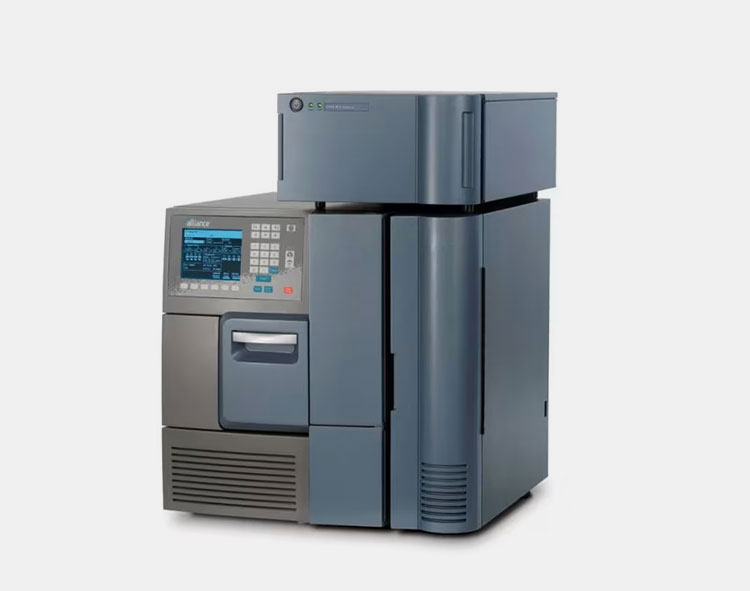
High Performance liquid chromatography (HPLC)
High performance liquid chromatography is used to detect the purity of the monoclonal antibodies. The column is fed with a liquid solution and the chromatography separates and measure the individual components present in the solution.
qPCR machine:
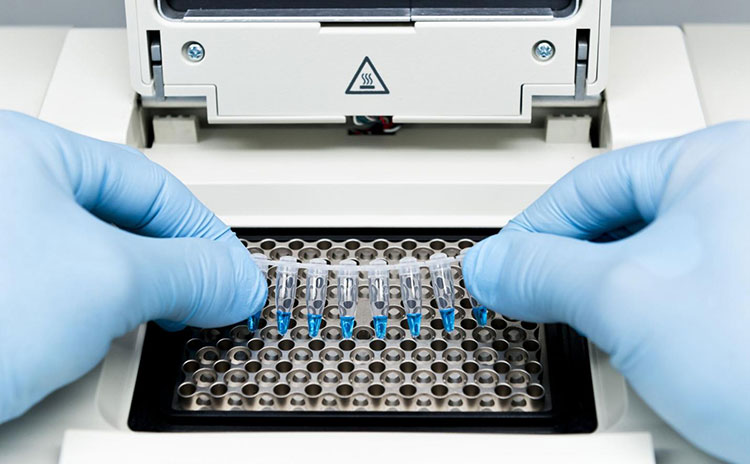
qPCR machine-Picture courtesy: gener8.net
Quantitative polymerase chain reaction (qPCR) machine is used to test the artificial DNA or gene sequence from production cell. Without gene sequence, the cells does not recognize how to produce the monoclonal antibodies. These cells are then insert into the living cells which is recombinant DNA. In this machine, the plasmids (the recombinant DNA) removed. It also detect the microbial DNA.
Labeling machine:

AIPAK labeling machine
The filled vials of monoclonal antibodies for dogs are then transferred to the labeling machine. The pre-printed labels having drug information, ingredients, dose, and way of administrating and storage conditions should to be printed on the vials. This ensures the correct usage of monoclonal antibodies for dogs and to store them correctly for effective results.
Cartoning machine:
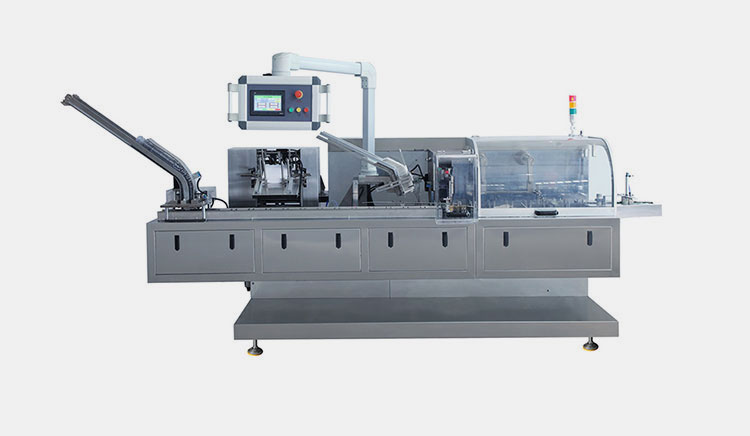
AIPAK cartoning machine
The filled vials are packed in the cartons to protect the product from UV light, high temperature, very low temperature and from external agents. The cartoning machine automatically form a very beautiful and neat boxes for monoclonal antibodies and these cartons are made from flat cartons fed to the cartoning machine.
9.Do monoclonal antibodies for dogs require the special storage temperature?
The monoclonal antibodies for dogs require proper temperature for its storage just like other biologics do. The proper temperature maintain the stability and affectivity of the product. If not properly stored, the monoclonal antibodies structure can get degrade and lose its effectiveness. The proper short and long term storage conditions for monoclonal antibodies for dogs are as follows:
For the short term storage of monoclonal antibodies which can be suitable for a few days to a few months depending on the product type, the temperature should be 2 °C to 8°C. If stored at this refrigerator temperature, the unopened vials last up to 6 to 12 months.
If you wants to store the monoclonal antibodies for dogs for a long term, specially used in research labs then store the monoclonal antibodies at -20°C to -80°C. But you should careful about not to freeze and de-freeze the monoclonal antibodies vials because this can degrade the antibodies.
Conclusion:
Monoclonal antibodies plays a vital role in the veterinary medicine. It can offers an outstanding performance in the dog s’ body against the allergy, inflammation, diseases and even cancer. Many monoclonal antibodies against the antigens have already discovered and some are under the research process. This FAQ guide of AIPAK Engineering in 2025 has provided you all the information regarding the monoclonal antibodies. Whether you are pet owner, manufacturer or researcher, this guide has provided you all the answers from benefits, risks, manufacturing to the storage of the monoclonal antibodies for dogs. If you still have any query, feel free to ask!
Don't forget to share this post!
CONTACT US
Tell us your raw material and project budget to get quotations within 24 hours.
WhatsApp Us: +86 181 7101 8586
 Tell us your material or budget, we'll reply you ASAP within 24 hours
Tell us your material or budget, we'll reply you ASAP within 24 hours

